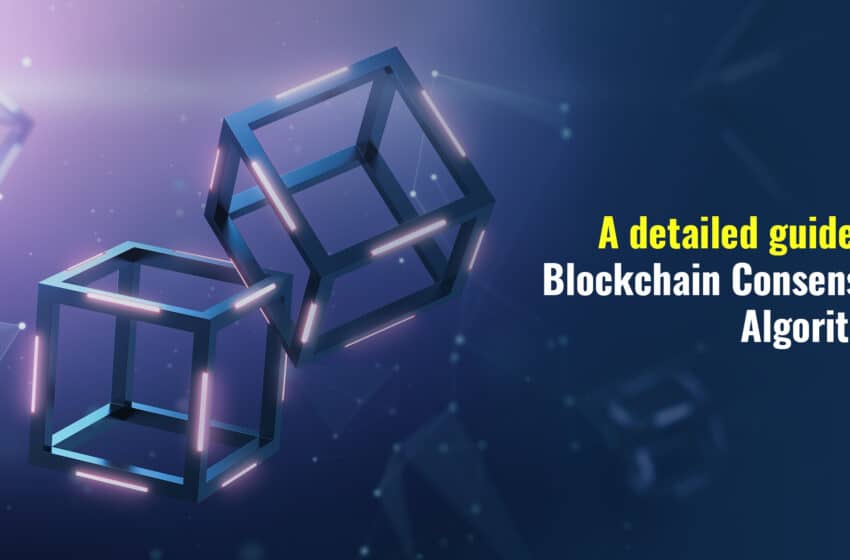A detailed guide to Blockchain Consensus Algorithm

A detailed guide to Blockchain Consensus Algorithm
Blockchain technology is gaining popularity, making profits, and benefiting organizations with its decentralized distributed network. Therefore, industries are investing and adopting blockchain technology. Many organizations are hiring blockchain professionals, and people are getting curious to know more about the technology. Blockchain plays a vital role in digitally transforming the world as it offers high transparency, privacy, security, and immutability. Now, how is blockchain able to achieve all this? And how does it manage to verify every transaction without having any centralized authority?
Table of Content
- What is the Blockchain Consensus Algorithm?
- The objective of Blockchain Consensus Algorithm
- Properties of Blockchain Consensus Algorithm
- Different Types of Blockchain Consensus Algorithms
- Conclusion
What is the blockchain Consensus Algorithm?
Blockchain Consensus Algorithm is a mechanism used at the core level of blockchain development in order to achieve a specific agreement in concern with the distributed ledger. Also, it is all about collaboration and cooperation at the peer-to-peer network for creating a reliable blockchain network.
Technically, a consensus mechanism manages every new block added to the blockchain, and it makes sure that every node creates the level of security, trust, and reliability. The blockchain consensus algorithm is the procedure in which every node and block follows the same structure and set of algorithms, leading to a secure environment. Thi results in a decentralized and private network to work efficiently without a central system or authority. Thus, the Blockchain consensus algorithm is said to be an essential part of Blockchain application development. Most of the DApps are built on blockchain consensus protocol.
Let us further discuss the features and objectives of the Blockchain consensus algorithm in detail.
The objective of Blockchain Consensus Algorithm
In blockchain technology, a consensus algorithm offers security, real-time value, and fault tolerance. To better understand the concept of the consensus mechanism and its importance, let us learn about its objective. The following points will make your concept clear and explain why consensus algorithms are used in blockchain development.
- Unified Agreement – The blockchain consensus mechanism achieves an agreement that has a specific protocol that everyone follows. The protocols are embedded in the distributed network ledger resulting in the data being true and accurate.
- Align Economic Incentive – With a consensus mechanism, participants get rewarded for good behavior. In contrast, others who wish to harm or exploit the system will have consequences.
- Fair and Equitable – Anyone can use the Blockchain network because of the consensus algorithm. It offers it as open-source and having a decentralized nature.
- Avert Double Spending – Only valid and verified transactions will be processed further, this is due to the blockchain consensus algorithm. It improves and prevents the problem of spending the cryptocurrency twice.
- Fault tolerance – another primary objective of the Blockchain algorithm is to make the blockchain apps secure from errors and recover from any node failure.
Also Read: You can now buy cryptocurrency with your PayPal
Properties of Blockchain Consensus Algorithm
Few features of blockchain consensus algorithm that are important pillars for developing blockchain platforms or apps are as follows-
- Safety and security- the first feature of the blockchain consensus Algorithm are to make sure that all the nodes result in a valid and authentic transaction or any process.
- Inclusive nature- this mechanism makes sure that a particular node of the network has the ability to process the voting.
- Participatory- In a consensus mechanism, each node can actively participate in storing the data.
- Egalitarian- It gives equal weightage to every node, which results in a suitable mechanism for the technology.
Types of Blockchain Consensus Algorithm
There are various Blockchain consensus Algorithm developed. However, some of the popular algorithms will be discussed in detail below. But first, check out the list of all Consensus Algorithms:
● Proof-of-Work
● Proof-of-Stake
● Delegated Proof-of-Stake
● Proof-of-Weight
● Proof of Elapsed Time
● Leased Proof-Of-Stake
● Simplified Byzantine Fault Tolerance
● Proof-of-Importance
● Proof-of-Capacity
● Practical Byzantine Fault Tolerance
● Proof-of-Burn
● Proof-of-Activity
● Directed Acyclic Graphs
● Delegated Byzantine Fault Tolerance
There are many consensus protocols in the blockchain market; however, we will be discussing some of the most popular ones.
Proof-of-Work (PoW)
Proof-of-work (PoW) is the most common and popular consensus mechanism used so far. Also, it is said to be a robust mechanism in blockchain technology where miners need to solve complex mathematical equations in order to produce a new block and send that further to the ledger. Now whenever a new block is created, it is approved by the miners before forwarding it further. Bitcoin runs on a Proof-of-Work consensus algorithm.
Proof-of-Stake (PoS)
In Proof-of-Stake (PoS) blockchain algorithm, the miners can approve a transaction based on how many coins they hold. The more coins they have staked, the more power they hold in mining new coins or adding a new block. Also, there is no coin rewarded in the PoS mechanism. In fact, miners get covered their transaction fees for successfully validating a block. It is an alternative to the original Proof-of-work mechanism. Blockchain platforms having a static coin supply approach is best suited for the Proof-of-Stake mechanism.
Delegated Proof-of-Stake (DPoS)
In DPoS, miners or coin holders do not validate the new block transaction. They vote the suitable delegate required to validate the block. Delegated Proof of Stake is able to run the orders much faster than any other blockchain consensus mechanism.
Proof of Capacity (PoC)
In PoC protocol, the solutions to the complex metaleptical equations or puzzles are stored into a hard drive. That stored data is then used to validate a new block. Therefore, this system reduces the cost of expensive hardware or burning coins.
Proof-of-Elapsed Time (PoET)
The Intel Corporation develops this consensus algorithm. It uses specialized hardware, which is designed by Intel corporation itself. For instance, Intel Software Guarded Extension (SGX), PoET uses it for block network ledger. The miners are selected based on their waiting time.
Conclusion
So far, we have discussed the Blockchain consensus algorithm in detail. It is essential to cover the vast knowledge about the consensus mechanism with its objectives and features for being a blockchain professional. Also, you must have extensive knowledge about the types of consensus algorithms used in blockchain platforms.


